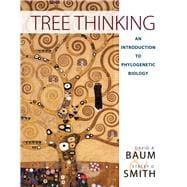
Note: Supplemental materials are not guaranteed with Rental or Used book purchases.
Purchase Benefits
What is included with this book?
David A. Baum is a professor at the University of Wisconsin, where he conducts research in plant systematics, systematic theory, and plant evolutionary developmental genetics. He earned his Ph.D. in Population and Evolutionary Biology from Washington University in 1991, conducted postdoctoral research at the University of Wisconsin, and then served as Assistant and Associate Professor of Organismic and Evolutionary Biology at Harvard University. He returned to the University of Wisconsin in 2001, and is now Professor and Chair of Botany and Director of the James F. Wright Institute for the Study of Evolution. Baum’s research has earned him awards including an Alfred P. Sloan Foundation Young Investigator Award, an NSF Career Award, and a John Simon Guggenheim Foundation Fellowship. In 2006 he was elected Fellow of the American Association for the Advancement of Science for “outstanding contributions in the investigation of plant evolution and for excellence in teaching and mentoring in phylogenetics and evolutionary biology.” Baum teaches phylogenetic biology at both the introductory and advanced levels and has been offering workshops on phylogenies and tree thinking for K-12 teachers since 1999.
Stacey D. Smith is professor at the University of Colorado, Boulder. Her research focuses on the evolution of floral diversity and spans the fields of phylogenetics, evolutionary genetics, comparative methods and pollination ecology. Supported by a British Marshall fellowship, she earned an M.Phil in Botanical Diversity from the Universities of Reading and Birmingham in the United Kingdom in 2001. She returned to the United States to pursue a doctoral degree in Systematic Botany at the University of Wisconsin-Madison. After obtaining her Ph.D. in 2006, she conducted postdoctoral research at Duke University through a National Institutes of Health Ruth L. Kirschstein Fellowship before joining the faculty at the University of Nebraska in 2010. She teaches introductory organismal biology and phylogenetic biology for undergraduate and graduate students and sponsors outreach events to promote public understanding of plant biology and evolution.
1. Introduction to phylogenetic trees and their importance in modern biology
2. Tree thinking and its importance in the development of evolutionary thought
3. What a phylogenetic tree represents
4. Trait evolution
5. Relatedness and biological classification
6. Gene trees and species trees
7. Phylogenetic inference with parsimony
8. Phylogenetic inference with distance, maximum likelihood and Bayesian methods
9. Statistical tests of phylogenetic hypotheses
10. Using trees to reconstruct evolutionary history
Answers to chapter quizzes
Literature cited
Glossary
Index
The New copy of this book will include any supplemental materials advertised. Please check the title of the book to determine if it should include any access cards, study guides, lab manuals, CDs, etc.
The Used, Rental and eBook copies of this book are not guaranteed to include any supplemental materials. Typically, only the book itself is included. This is true even if the title states it includes any access cards, study guides, lab manuals, CDs, etc.